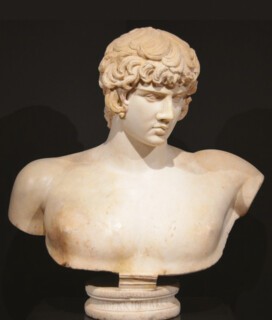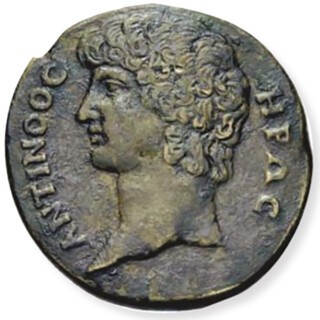In December 362 ce, Julian the Apostate wrote a short satire on the occasion of the Bacchanalia. It took the form of a commentary whispered to Bacchus by the old satyr Silenus as each former Caesar arrived at a banquet of the gods. After Augustus, Tiberius, Nero and Caesar himself, Hadrian appeared, ‘an austere-looking man with a long beard, an adept in all the arts … always gazing at the heavens and prying into hidden things’. On seeing him, Silenus said: ‘What do you think of this sophist? Can he be looking here for Antinous? One of you should tell him that the youth is not here.’
Hadrian would have improved the odds of encountering Antinous considerably if he had lowered his gaze. On earth, images of his favourite abounded. All over the Roman Empire contemporaries would have been able to echo the words of Pausanias the Periegete: ‘I never saw him when he was among humans but I have seen him in statues and paintings.’ Little is known about Antinous beyond his birthplace of Bithynium in Bithynia. As a youth he joined Hadrian’s retinue and travelled with him to Egypt. Later writers have assumed they were lovers. After Antinous’ early death, a temple to him was established at Mantineia, whose citizens remembered that they were supposed to have been the founders of the imperial beloved’s hometown. It had a gymnasium full of Antinouses in marble and paint. Less public was the Antinoeion, a shrine built by Hadrian at Tivoli. Egypt had an entire city named after him, Antinoupolis, complete with a circus, a theatre, a racetrack, and streets lined with long colonnades that were still solidly perpendicular in the time of the Description de l’Egypte (1809), but recycled not long afterwards to build the walls of a sugar factory.
It was here by the Nile in October 130 that Hadrian last saw Antinous. The historian Cassius Dio claimed that Hadrian wrote of Antinous’ death in his Memoirs: he had drowned; it was an accident. ‘The truth’, Dio wrote, was that Antinous had ‘offered himself in sacrifice’ to achieve some mystical purpose on Hadrian’s behalf. A ‘new’ star in the constellation, Aquila, was discovered to be Antinous’ spirit stellified, and a cult was born, which spread across the Mediterranean, with Antinous assimilated to Osiris in Egypt and Dionysus elsewhere. He was celebrated in temples and games and his portrait was reproduced on gems, coins, silver bowls, as well as in paintings and statues.
Many of these statues and all the paintings have been lost, but there are still 88 sculpted Antinouses littering the world’s museums, his familiar face surprising you in unvisited corners of rooms of Roman sculpture from Denmark to Brazil; very occasionally new ones turn up, the soil disclosing his diagnostic handsomeness little by little. Statues of Antinous manage to be at once generically, classically handsome and perfectly distinctive, mainly because the details of his idealisation are always reproduced so precisely: the particular angle of the neck as he looks down over his left shoulder, the precise design of particular locks of hair, in a natural tousled style half covering his ears.
A tiny single-room exhibition at the Ashmolean (until 24 February) focuses on one of the best of these, an Antinous bust from Syria dedicated by one Marcus Lucceius Flaccus ‘to Antinous Hērōs’ (‘Antinous the demi-god’) and recently restored. He is accompanied by several other Antinouses, mostly plaster casts, and some commemorative coins. The extreme similarity of these original and copied Antinouses makes a single point very effectively; there must have been an official model promulgated from Rome and followed by more or less skilled artists all over Italy and the eastern Mediterranean.
The transmogrification of emperors and people close to emperors into divine personalities, or divi, worthy of being worshipped as gods, wasn’t a novelty in the second century ce. Among others, Caligula had deified his sister Drusilla, Nero his second wife, Poppaea, and Trajan his niece Matidia. These divi and divae were officially sanctioned by the Senate and were closely associated with the cult of the emperors to whom they owed their ascension. But there were no great sanctuaries, so far as we can tell, dedicated to Matidia; no identically faced sculptures honoured Drusilla; no newly founded city of Poppaeopolis marked the spot where Nero, allegedly, kicked his pregnant queen to death. Antinous was different.
When I visited the exhibition last year it shared the room with another show, No Offence: Exploring LGBTQ+ Histories, but the organisers of the exhibition and certainly Roland Smith, the main author of the very useful little catalogue, Antinous: Boy Made God (Ashmolean, £15), suggest that Antinous’ relationship to Hadrian was less central to his cult than we have supposed: ‘Antinous’ veneration seems to have been largely an independent phenomenon … [Flaccus’] bust was dedicated to the boy in and for himself.’ He even suggests that it was the proliferation of monuments that gave rise to rumours of a relationship.
Hidden away in the catalogue is an even more startling claim, derived from close examination of the pubic region of a few full-length nude Antinouses: Antinous had not reached puberty when he died. ‘There are obvious implications for his relationship with Hadrian,’ Smith suggests mysteriously, ‘and the vexed question of the date he joined the imperial retinue – surely not long before ad 130.’ By this I suppose he means that any relationship was brief and not nearly as intimate as has previously been supposed. Plutarch refers to the Roman custom of keeping little boys called deliciae as ‘playthings’; there are the notorious cases of Tiberius’ ‘minnows’, Nero’s Sporus and Commodus’ Philocommodus, who was said to wander around the palace naked but for jewellery and gold chains. The term is often translated ‘catamite’, but deliciae were not supposed to be abused. Plutarch was referring to a boy kept by the moralistic Augustus; it is highly unlikely that their relationship was sexual. Nero and Commodus were hardly exemplars of acceptable norms of behaviour, while Suetonius describes the stories of Tiberius’ genital-nibbling ‘minnows’ as ‘grosser depravities that one can hardly bear to tell or to hear told, let alone believe’.
But was Antinous really so young? Smith is quite insistent and suggests there must have been an official set of genitals to be precisely imitated as well as the official three-quarter bust. I am not convinced. Broad-chested square-jawed Antinous does not look like a little boy to me, nor did he to Julian who, presumably in response to images he had seen, refers to him as a meirakion, a young citizen aged 18 or 19. Moreover, early Christian historians, who were hostile to Hadrian, never mention that Antinous was so young although this would certainly have added to the contumely they directed at him. Smith is (over-)keen to prove a point about the secrets lost to written history that can be revealed only by close examination of stones, but what ancient viewers tell us they saw in those stones has a powerful salience.
The pubes remain a problem. Perhaps the official pubes were designed to emphasise the chasteness of Hadrian’s interest. Perhaps Hadrian’s philhellenic revival of 500-year-old classical norms, like Greek love and not shaving, had discombobulated the sex-sign system, which anyhow had never mapped with any degree of realism onto the range of things ancient men and boys carried between their legs. And why should Antinous, qua god, be restricted to his age at time of death? Ganymede slides up and down the age-scale from little boy to the verge of manhood. Hermes and Dionysus were depicted at all stages of maturity. There is a bearded Apollo and a boy Zeus. Even mortals were regularly ‘youthened’ after death.
The idea that the cult of Antinous was ‘independent’ of Hadrian comes up against similar objections. The catalogue authors do not claim later dates for the images, so it seems they agree that they stopped being made immediately after the emperor’s death in 138; although Antinoupolis continued to flourish, the extraordinary production of paintings, coins and statues was by and large confined to just eight years. Antinous’ connection with Hadrian was of central importance – when the Athenians added a new deme, or parish, of Antinoeis to their ancient list, they placed it in the group belonging to Hadrian, and one particularly suggestive image has Antinous’ head emblazoned on Hadrian’s chest, like the gorgon’s head on Athena’s aegis. But the cult was at the same time somewhat apart from the state-sponsored imperial cult of the royal family. Maybe this was the source of Antinous’ attraction to his devotees: a more intimate and particular connection to the imperial power than that provided by state religion.
Subsequent generations universally saw the Antinous phenomenon as a reflection on Hadrian, his lust or his mystic proclivities or, in Julian’s words, his ‘madness and folly’. It seems rather unfair that the builder of the Pantheon, of the temple of Olympian Zeus, the man who could be said to have presided over the Roman Empire at its peak of peace and prosperity, should now be remembered for his passion for a boy from Bithynia, but that does not mean his passion was made up. After all, Antinous was by all accounts very good-looking.
Send Letters To:
The Editor
London Review of Books,
28 Little Russell Street
London, WC1A 2HN
letters@lrb.co.uk
Please include name, address, and a telephone number.



